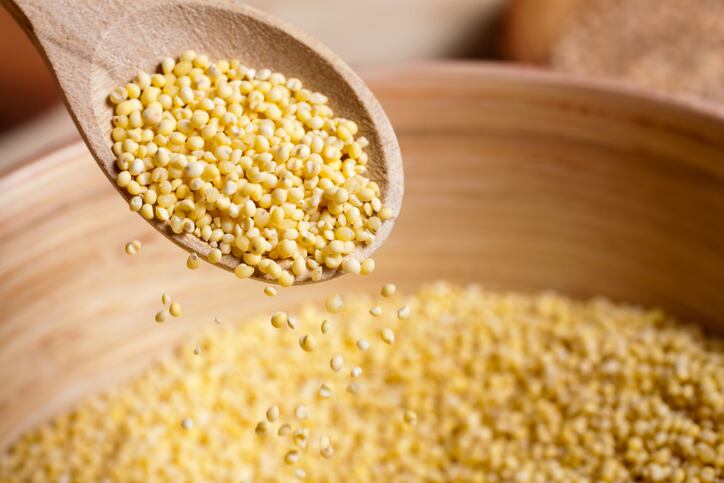Touted as a forgotten staple, millets were traditionally consumed in African and Asian countries but later replaced by the “Big 3” which are rice, wheat and maize.
Millets are a low glycaemic index (GI) staple and have been demonstrated to improve glycaemic control.
However, the studies on millets were largely inconsistent in terms of the type of millets used, outcomes, and processing method including cooking.
A group of researchers from leading research institutions in India, Japan, Malawi, and UK reviewed 65 human studies involving almost 1,000 non-diabetic, pre-diabetic, and diabetic subjects on five key outcomes, and included 11 types of millets, one mixed millet, and different processing methods.
There are currently 13 types of millets available globally including pearl millet, finger millet and sorghum.
“This paper for the first time aims to undertake an in-depth systematic review and meta-analysis of all the studies conducted to test GI, fasting and post-prandial blood glucose concentrations, insulin response and HbA1c biomarker level in millet-based diets,” they wrote in Frontiers in Nutrition.
Blood glucose results
Results revealed that long-term consumption of millets for more than three months significantly reduced fasting and post-prandial blood glucose levels in diabetic subjects by 12 and 15% respectively.
Findings also suggest that long-term consumption of millets for non-diabetic and pre-diabetic subjects also had a significant effect on reducing fasting blood glucose levels compared to a regular rice or wheat-based diet.
“This is evidence of millets' effect on averting rising blood glucose levels and preventing pre-diabetic individuals from entering the diabetic stage. However, more studies are needed to reconfirm this,” researchers said.
HbA1c results
Unlike fasting blood glucose levels, HbA1c is an indicator of long-term glycaemic control since it reflects the average blood glucose level typically over a period of 8 to 12 weeks.
Results showed that long-term consumption of millets was associated significantly with reduced HbA1c marker levels in both pre-diabetic and diabetic subjects compared to consuming a regular rice or wheat-based diet.
Overall, there was a 15% reduction in HbA1c level for diabetic subjects.
In pre-diabetic subjects, HbA1c levels dropped to the normal reference level, an average reduction of 17%.
Researchers explained the reduction was due to the high fibre content and low glycaemic index of the millet-based diet, which reduced the availability of glucose to form HbA1c.
Millets have a low average glycemic index of 52.7, about 36% lower GI than milled rice and refined wheat.
The study also reported a significant reduction in fasting insulin level and mean insulin sensitivity with long-term millet consumption.
These findings confirmed that millets can be beneficial in managing and reducing the risk of developing diabetes and could therefore be used to design appropriate meals for diabetic and pre-diabetic subjects as well as for non-diabetic people for a preventive approach.
This study was supported by the International Crops Research Institute for the Semi-Arid Tropics (ICRISAT)’s Smart Food Endowment fund.
From forgotten to unforgettable
“We believe the full potential of millets for the consumer, planet and farmer can only be tapped if millets are restored to the plate as staples. If unprocessed or minimally processed millets diversify the commonly consumed staples or become staples themselves, we will be utilising millets to their fullest and make them “unforgotten”,” said Dr Seetha Anitha, the study’s lead author and a senior nutrition scientist at ICRISAT
However, she added a new approach to target the whole millet value chain was needed.
“Consumers need to know how to cook them in ways that make their consumption appetising without losing health and nutritional benefits. [Often] the lack of knowledge of cooking millets contributes to making them forgotten,” she told NutraIngredients-Asia.
Dr Anitha said simple cooking method such as boiling millets in water or making porridge will be more beneficial than deep frying and adding ingredients such as fats and oil.
In the current study, it was reported that all cooking methods raised GI value of the millets.
Steaming, baking and boiling raised the GI of millets by up to 18.4 units, 16.3 units and 11.3 units, respectively.
“We hope our studies will provide the industry the much needed scientific case for using millets in ways that do not alter their nutritional profile. Some such ways include making millet based products with high proportion of millets, mixing them with pulses, choosing the appropriate cooking method that preserves its nutritional value and keep them at low GI level.
“The scope to innovate them into foods is endless and in turn implies a big entrepreneurial potential.”
Policies also influence the consumption of crops. For instance, Kenya has mandated the mixing of maize flour with flour of forgotten grains like millets.
India has also called for the inclusion of millets in its school feeding programme.
This study is the first of a series of studies on millets which will include managing lipid profile, hypertension, obesity, reducing the risk of developing cardiovascular disease, anemia, as well as its beneficial effect on calcium deficiencies and growth parameters. These will be published throughout the year.
“We hope that our studies will convince more of the food industry to take to millets. We are already witnessing an upward trend in the industry and in the consumption of convenience food products with millets, which is encouraging,” added Dr Anitha.
Source: Frontiers in Nutrition
https://doi.org/10.3389/fnut.2021.687428
“A Systematic Review and Meta-Analysis of the Potential of Millets for Managing and Reducing the Risk of Developing Diabetes Mellitus”
Authors: Seetha Anitha, et al.




